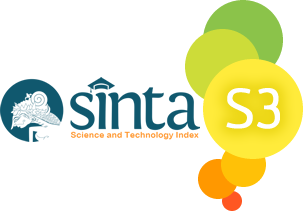Author Guidelines
Rank 2 (Uppercase Lower Upright Flat Font with Left Edges and Blackened)
Rank 3 (Uppercase, Lower Leaning Letters with Left Bank and Blackened)
Rank 4 (uppercase and lowercase flat on the left edge and not blacked)
Abstract: This is a miniature of the contents of the entire article covering problems, objectives, methods, results, conclusions, and suggestions, written in Indonesian and English with a maximum of 150 words.
Keywords: Contains concepts contained in articles, written in Indonesian and English consisting of 3 to 5 concepts.
Introduction: This section contains research problems and is presented explicitly supported by relevant data and facts. The preliminary load consists of a general description of the problem (variable) under study, showing data related to the problem (variable) studied, a description of the possible causes of the problem, a description of the negative effect if the condition remains unchecked, and a description of the general limitation of what was studied.
Theory Concepts: Contains efforts to identify relevant and logical theories so that the reasons for the problem and research objectives can be conceptualized to be tested and analyzed.
Research Methods: Explain how the research procedures carried out include the research design, population/sample or informant, instruments, and data analysis techniques.
Results and Discussion: The results contain data analysis which is accompanied by illustrations such as pictures, photographs, tables, and graphs. While the discussion includes interpretations of research results that are linked to theoretical concepts, relevant research results, and theoretical and practical implications. In the discussion, critical analysis and synthesis sharpness are needed.
Closing: Written in essay form, contains the essence of the combination of results with discussion and not just a summary.
Reference: Priority references are sourced from primary literature such as accredited National and International journals, research results, dissertations, theses, and theses. Reference updates last 10 years, sorted alphabetically and chronologically.
Use of Illustrations in Articles
For words that have madd (length), use the formulation below:
|
ا = a |
Ø® = kh |
Ø´ = sy |
غ = gh |
Ù† = n |
|
ب = b |
د = d |
ص = sh |
Ù = f |
Ùˆ = w |
|
ت = t |
Ø° = dz |
ض = dh |
Ù‚ = q |
Ù‡ = h |
|
Ø« = ts |
ر = r |
Ø· = th |
Ùƒ = k |
ء = ’ |
|
ج = j |
ز = z |
ظ = zh |
Ù„ = l |
ÙŠ = ya |
|
Ø = h |
س = s |
ع = ‘ |
Ù… = m |
|
î = i long, like, al-ʻaqîdah wa al-syarî`ah
û = u long, like al-dustûr
Guidelines for Citing in Articles
* Religious maturity can be identified as maturity in the faith because the essence of religion is faith (Ulfa, 2005: 25).
* According to Al-Attas (1990: 64) Ta'dib is the right term to indicate Islamic education because the proposition of the concept of education and the educational process has been covered.
Guidelines for Writing Reference Lists
Writing a reference list in the Jurnal Pendidikan Agama Islam Al-Thariqah uses the MLA (Modern Language Association) pattern. Example:
The Holy Qur'an
Departemen Agama RI. Al-Qur’an dan Terjemahannya. Bandung: Darus Sunnah, 2015.
Book
Al-Abrasyi, M. ‘Athiyah. Prinsip-prinsip Dasar Pendidikan Islam. Bandung: Pustaka Setia, 2003.
Al-Rasydin, dan Ja’far. Filsafat Ilmu dalam Tradisi Islam. Medan: Perdana Publishing, 2015.
Article/Journal
Harahap, Musaddad. "Refleksi Dinamika Kebebasan Akademis dalam Pendidikan Islam." Jurnal Pendidikan Agama Islam Al-Thariqah 1.1 (2017): 87-103.
Harahap, Musaddad, dan Lina Mayasari Siregar. "Rekontekstualisasi Sejarah: Kontribusi Lembaga Pendidikan Islam terhadap Dakwah Rasulullah SAW." Jurnal Pendidikan Agama Islam (Journal of Islamic Education Studies) 5.2 (2017): 288-308.
Research
Ahmad, Muhammad Yusuf. Model Kepemimpinan Kepala MTs. dalam Meningkatkan Mutu Pendidikan di Kota Pekanbaru. Disertasi, UIN Suska Riau, 2018.
Notes:
Please check here the Indonesian language author guidelines.











